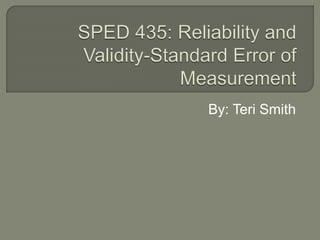
Standard error of measurement
- 2. The simplest, most non-technical way to think of the standard error of measurement (SEM) is the following: If a single student were to take the same test repeatedly (with no new learning taking place between testings and no memory of question effects), the standard deviation of his/her repeated test scores is denoted as the standard error of measurement.
- 3. You use SEM to determine how reliable a test is and if you can have confidence in the scores you get from that test. You would use SEM in your classroom to find out how much that students score could change on re-testing with the same test or something close to the same test. The test scores could be considered an estimate of the student’s achievement level.
- 4. This video is about Standard Error of Measurement and how to calculate it and why you may use Standard Error Of Measurement https://www.youtube.com/watch?v=PZDD Wd-jUzM https://www.youtube.com/watch?v=Nuxg-qoqPTw
- 5. www.tea.state.tx.us/WorkArea/linkit.aspx ?LinkIdentifier=id&ItemID=... http://www.indiana.edu/~best/bweb3/test-reliability/
- 7. “True” Score is a calculation that is founded in theory and research that the farther from a test mean a particular student’s score is , the greater the chance for error within the obtained score. (123) This is just another way of calculating a students score but is supposed to be a better estimation than Standard Error of Measurement.
- 8. “True” score is a powerful model for measurement it reminds us that most measurement has an error component. The estimated “true” scores can be used to find a range of scores by using the standard error of measurement for the estimated “true” score.
- 9. Estimated True Score= M + r( X – M) • M = mean of group of which person is a member • r = reliability coefficient • X = obtained score
- 10. Using the formula for estimated “true” score, the calculation for an obtained score of 115 with an r of .78 and a mean of 100. • Estimated “true” score = 100 + .78 (115 – 100) =100 + .78 (15) =100 + .11.7 =111.7 In this example, 111.7 is closer to the mean of 100 than 115.
- 11. Assessing Learners with Special Needs an Applied Approach. http://www.socialresearchmethods.net/kb/tr uescor.php